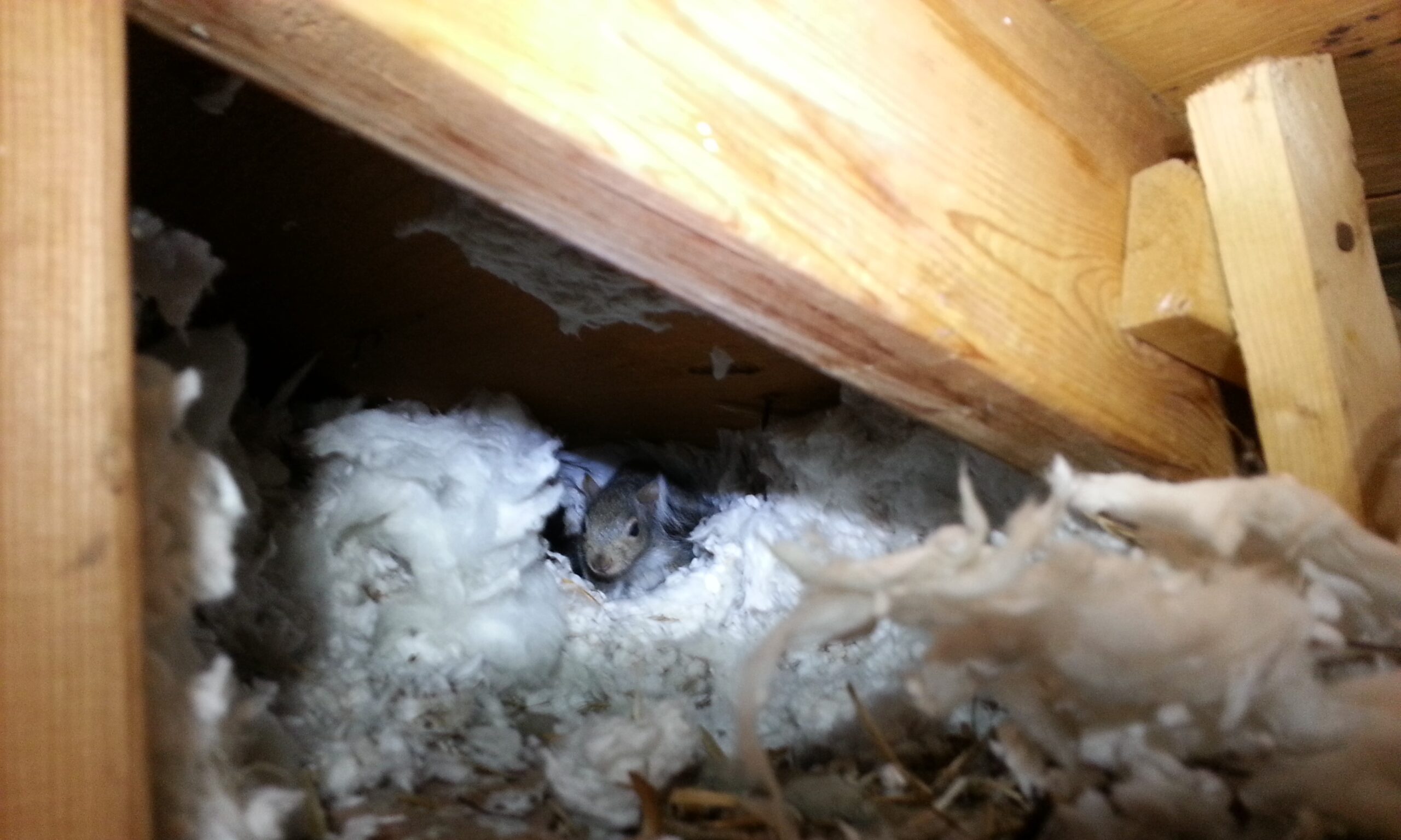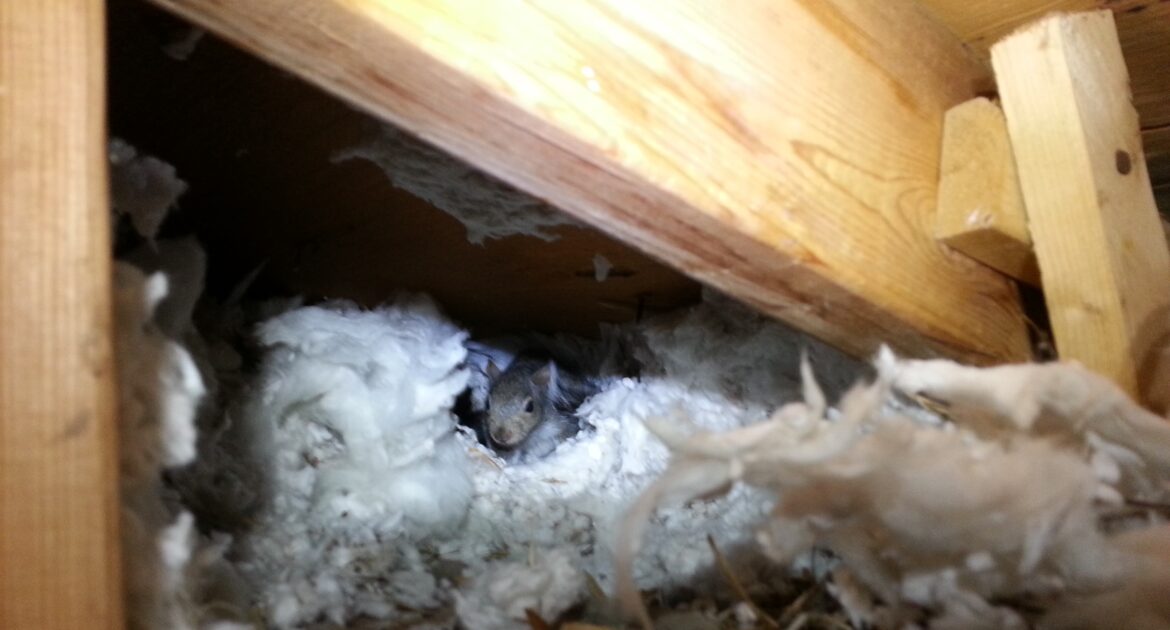Squirrels may seem harmless as they scurry about trees, but when they enter your home, they can cause significant problems. They often find their way inside through small openings, such as gaps in vents, chimneys, or rooflines, leaving many wondering how do squirrels get in your house in the first place. Once inside, they frequently settle in attics, using insulation and other materials to build their nests. If you’re curious about what a squirrel nest looks like, you’re likely searching for compact collections of twigs, leaves, and shredded fabric or paper tucked away in corners or between beams. There are several telltale signs of squirrels in attic spaces, such as scampering noises, visible damage like gnawed wires or wood, and droppings scattered around. Addressing these issues quickly is crucial to prevent extensive damage and ensure the safety of your home.
Noises Coming from the Attic or Walls
One of the clearest indicators of squirrels in your home is the sound of movement in the attic or walls, especially during early morning or late evening hours when they’re most active. Squirrels are diurnal, meaning they’re awake during the day, and the noise they make can resemble scurrying, scratching, or even gnawing. If you hear sounds of activity above your ceiling or behind your walls, it could be a sign of squirrels building a nest or gathering food.
Squirrels are also highly territorial within confined spaces. You might hear louder noises consistent with what seems like fighting or chasing. These animals are particularly vocal, so don’t be surprised to hear chirps, squeaks, or even growls. While some noises can overlap with other wildlife, squirrels have a tendency to stick close to the areas they’ve claimed, often in attics, eaves, or wall voids. Over time, ignoring these sounds can allow the problem to grow and compound, creating larger damage to your home.
Beyond the disruption of noise, the chewing behavior of squirrels is a severe issue. They can gnaw through vital structures, including electrical wires, which can potentially cause fire hazards if left unchecked. Hearing persistent scratching or gnawing sounds is a strong signal that it’s time to investigate further.
Visible Entry Points and Signs of Chewing
When squirrels make their way into your home, they often leave physical evidence near their entry points. Thanks to their sharp, ever-growing teeth, they can gnaw through wood, aluminum, vinyl siding, and even plastic vents. If you notice damaged soffits, fascias, or gaps in your roofline, pay close attention—these could be how squirrels have accessed your attic.
One common question homeowners ask is, “How do squirrels get in your house?” The answer often lies in the structure of your home. Even small gaps of two inches or less can allow squirrels to squeeze through. They are excellent climbers and can access your roof via tree branches, power lines, or even textured walls. Once they’re on the roof, they’ll look for vulnerable spots to chew open. These vulnerabilities may include damage caused by weather or aging materials, which make it easier for squirrels to break in.
- Chewing damage on exterior surfaces like shingles, roof vents, or chimney exits
- Claw marks or scratches near these areas
- Rapid escalation of damage once squirrels enter, including chewing on support beams, wires, and insulation in the attic
- Conduct a visual inspection around your home’s perimeter for damaged sections or chew marks
- Early detection can prevent more serious damage
Evidence of Nesting Materials or Droppings
If you suspect squirrels have moved into your attic, look for signs of nesting materials. Squirrels use natural elements such as twigs, dry leaves, and shredded insulation to create a warm and secure environment for their litter. These nests are often located in dark, hidden areas such as attics, wall voids, or eaves. Depending on the size of the population, the nesting site may grow quite large and be easily identified by its dry, messy appearance.
Squirrels are prolific breeders that have two litters per year, with babies arriving between February and April and again in late summer. If a female has established a nest, you may also notice an accumulation of smaller droppings near the nesting site. These droppings are usually similar in appearance to those of a rodent—elongated and slightly tapered at the ends. Finding this evidence is crucial, as droppings can carry health risks and should be removed with care and proper cleaning methods once the animals have been safely removed.
Beyond nesting materials and droppings, you might also spot signs of food storage. Squirrels often bring acorns, nuts, or discarded shells into their nest to prepare for colder months. This hoarding behavior adds another layer of disruption and mess to your home, piling up near the nest or hidden in attic corners. Instead of waiting for visible damage to worsen, identifying these materials early on can help prompt swift action.
What Does a Squirrel Nest Look Like?
Squirrel nests, also known as dreys, are typically composed of a combination of natural and man-made materials. Outside, these nests can often be seen high up in trees, where they resemble large, spherical clusters of leaves, twigs, and moss. However, when squirrels build nests inside your home, such as in your attic, the construction becomes more varied. Inside, they utilize materials like insulation, fabric, paper, and even plastic to create a soft, insulated, and hidden environment where they can raise their young and sleep.
When inspecting your attic for a possible squirrel nest, look for compact, dry clusters of these materials tucked away in dark corners, between beams, or near warm spots like pipes or vents. A squirrel nest will often appear messy at first glance but serves as a highly organized shelter for the animals. These nests are not only a nuisance but can also cause structural damage and pose a fire risk due to the materials collected near wires or other potential ignition points. Addressing nests promptly is essential to minimize health hazards and structural damage in your home.
Skedaddle Is Your Trusted Choice for Wildlife Control
If you’re dealing with a squirrel infestation and want prompt, reliable, and professional solutions, Skedaddle is here to help. Our team of trained technicians specializes in humane removal processes that prioritize the well-being of the squirrels and the integrity of your property. We go beyond simply capturing and removing the squirrels; our process includes reuniting any young squirrels with their mothers outdoors, ensuring their safety, and minimizing any disruption to their natural habitat.
Here’s what you can expect with Skedaddle:
- Humane squirrel removal techniques.
- Comprehensive sealing of entry points with durable materials.
- Cleaning and disinfection of contaminated areas.
- A lifetime warranty for long-term protection.
With Skedaddle, you can have peace of mind knowing that we don’t just stop at removal. We take proactive measures to prevent future problems and ensure your property is safeguarded. Don’t let squirrel damage worsen—take action now to restore your peace of mind.
Stop the Damage Before It Worsens
Squirrels may seem like harmless animals, but their presence in your home can lead to extensive damage over time. From chewing wires to ruining insulation and creating health hazards, it’s essential to address the issue as soon as you suspect a problem. By staying vigilant to the signs we’ve discussed—noises in your attic, visible entry points, and evidence of nests—you can take action to avoid costly repairs and greater harm to your property.
If you’re dealing with an active squirrel problem, don’t wait for the damage to escalate. Contact Skedaddle Humane Wildlife Control today, and we’ll provide a comprehensive inspection and removal plan. With our expertise and dedication, we’ll ensure your home is secure and squirrel-free for good. Call us now to reclaim your peace of mind—it’s time to make your home safe again.




